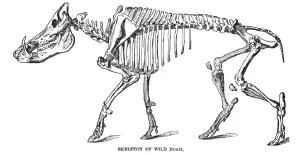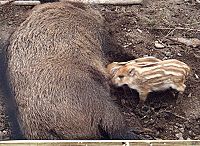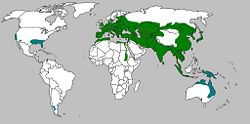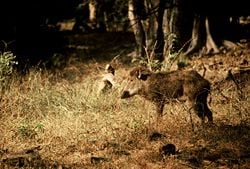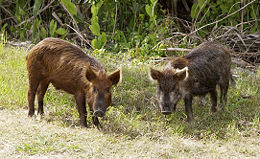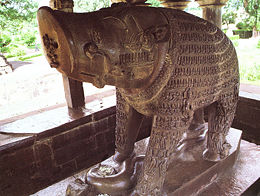Boar
| Wild Boar | ||||||||||||||
|---|---|---|---|---|---|---|---|---|---|---|---|---|---|---|
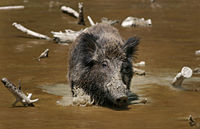 | ||||||||||||||
| Scientific classification | ||||||||||||||
| ||||||||||||||
| Sus scrofa Linnaeus, 1758 |
Boar, or wild boar, is an omnivorous, gregarious mammal, Sus scrofa of the biological family Suidae, characterized by large heads with tusks and a distinctive snout with a disk-shaped nose, short necks, relatively small eyes, prominent ears, and a coat that has dense, dark bristles. This wild species is the ancestor of the domestic pig, Sus scrofa domesticus, which was one of the first domesticated animals (Seward 2007).
The boar is native across much of Central Europe, the Mediterranean Region (including North Africa's Atlas Mountains), and much of Asia, as far south as Indonesia, and has been introduced elsewhere. Although common in France, the wild boar became extinct in Great Britain and Ireland by the seventeenth century, but wild breeding populations have recently returned in some areas, following escapes from boar farms (Goulding and Smith 1998).
Valued as food and for their bristly hair, which historically has been used for toothbrushes, and currently is used for hairbrushes and paintbrushes, the boar also adds to the wonder of nature for people. Ecologically, boars provide important functions in food chains, consuming a very wide variety of plant and animal matter, and being consumed by wolves, tigers, and other large predators.
The term boar also is used more generally to denote an adult male of certain speciesâincluding, confusingly, domestic pigs. It also applies to the males of such mammals as the guinea pig, badger, skunk, raccoon, and mink. However, for the wild boar, the term applies to the whole species, including, for instance, "sow wild boar" (female wild boar) or "wild boar piglet."
Physical characteristics
As with other members of the Suidae family, wild boars have four toes on each foot and walk only on the middle two digits, with the others staying clear of the ground. The body of the wild boar is compact, the head is large, and the legs are relatively short.
The fur consists of stiff bristles and usually finer fur. The color usually varies from dark gray to black or brown, but there are great regional differences in color; even whitish animals are known from central Asia (Heptner and Sludskii 1989). During winter, the fur is much denser. Wild boar piglets are colored differently from adults, being a soft brown with longitudinal darker stripes. The stripes fade by the time the piglet is about half-grown, when the animal takes on the adult's grizzled gray or brown color.
Adult boars average 100 to 150 centimeters (39 to 59 inches) in length and have a shoulder height of 90 centimeters (35 inches) (Scheggi 1999). As a whole, their average weight is 60 to 70 kilograms (132-154 pounds), though boars show a great deal of weight variation within their geographical ranges. Boars shot in Tuscany have been recorded to weigh 150 kilograms (331 pounds). A French specimen shot in Negremont forest in Ardenne, in 1999, weighed 227 kilograms (550 pounds). Carpathian boars have been recorded to reach weights of 200 kilograms (441 pouns), while Romanian and Russian boars can reach weights of 300 kilograms (661 pounds) (Scheggi 1999).
The continuously growing tusks (the canine teeth) serve as weapons and burrowing tools. The lower tusks of an adult male measure about 20 centimeters (7.9 inches), from which seldom more than 10 centimeters (3.9 inches) protrude out of the mouth); in exceptional cases the lower tusks of males may be even 30 centimeters in length (12 inches). The upper tusks are bent upwards in males, and are regularly ground against each other to produce sharp edges. In females they are smaller, and the upper tusks are only slightly bent upwards in older individuals.
As with other members of Suidae, the males possess a corkscrew-shaped penis, which fits into a similarly shaped groove in the female's cervix.
Behavior
Wild boars live in groups called sounders. Sounders typically contain around twenty animals, but groups of over fifty have been seen. In a typical sounder, there are two or three sows and their several offspring; adult males are not part of the sounder outside of a breeding cycle, and are usually found alone. Breeding takes place two to three times per year. Birth, called farrowing, usually occurs in a secluded area away from the sounder; a litter will typically contain 8 to 12 piglets (Goulding and Smith 1998).
The animals are usually nocturnal, foraging from dusk until dawn but with resting periods during both night and day (Goulding and Smith 1998). They eat almost anything they come across, including grass, nuts, berries, carrion, roots, tubers, refuse, insects, small reptilesâeven young deer and lambs (Goulding and Smith 1998).
Boars are the only hoofed animals known to dig burrows, a habit that can be explained by the fact that they are the only known mammals lacking brown adipose tissue, where cellular reactions allow conversion of fats into heat. Therefore, they need to find other ways to protect themselves from the cold. For the same reason, piglets often shiver to produce heat themselves (Scullion 2007).
If surprised or cornered, a boar (and particularly a sow with her piglets) can and will defend itself and its young with intense vigor. The male lowers its head, charges, and then slashes upward with its large tusks. The female charges with its head up, mouth wide, and bites. Such attacks are not often fatal to humans, but severe trauma, dismemberment, and blood loss can very easily result.
Range
Historic range
The wild boar was originally found in North Africa and much of Eurasia from the British Isles to Japan and the Sunda Islands. In the north, it reached southern Scandinavia and southern Siberia. Within this range, it was absent in extremely dry deserts and alpine zones.
A few centuries ago, it was found in North Africa along the Nile valley up to Khartum and north of the Sahara. The reconstructed northern boundary of the range in Asia ran from Lake Ladoga (at 60°N) through the area of Novgorod and Moscow into the southern Ural, where it reached 52°N. From there the boundary passed Ishim and farther east the Irtysh at 56°N. In the eastern Baraba steppe (near Novosibirsk), the boundary turned steep south, encircled the Altai Mountains, and went again eastward including the Tannu-Ola Mountains and Lake Baikal. From here the boundary went slightly north of the Amur River eastward to its lower reaches at the China Sea. At Sachalin there are only fossil reports of wild boar. The southern boundaries in Europe and Asia were almost everywhere identical to the sea shores of these continents.
In dry deserts and high mountain ranges, the wild boar is naturally absent. So it is absent in the dry regions of Mongolia from 44-46°N southward, in China westward of Sichuan, and in India north of the Himalaya. In high altitudes of Pamir and Tien Shan they are also absent; however, at Tarim basin and on the lower slopes of the Tien Shan they do occur (Heptner and Sludskii 1989).
Present range
In recent centuries, the range of wild boar changed dramatically because of hunting by humans. They probably became extinct in Great Britain in the thirteenth century: Certainly none remained in southern England by 1610, when King James I reintroduced them to Windsor Great Park. This attempt failed due to poaching, and later attempts met the same fate. By 1700, there were no wild boar remaining in Britain.
In Denmark, the last boar was shot at the beginning of the nineteenth century, and in 1900, they were absent in Tunisia and Sudan and large areas of Germany, Austria, and Italy. In Russia, they were extinct in wide areas in the 1930s, and the northern boundary has shifted far to the south, especially in the parts to the west of the Altai Mountains.
By contrast, a strong and growing population of boar has remained in France, where they are hunted for food and sport, especially in the rural central and southern parts of that country.
By 1950, wild boar had once again reached their original northern boundary in many parts of their Asiatic range. By 1960, they reached Saint Petersburg and Moscow, and by 1975, they were to be found in Archangelsk and Astrakhan. In the 1970s, they again occurred in Denmark and Sweden, where captive animals escaped and survive in the wild. In the 1990s, they migrated into Tuscany in Italy.
Status in Britain
Between their extinction in Britain and the 1980s, when wild boar farming began, only a handful of captive wild boar, imported from the continent, were present in Britain. Because wild boar are included in the Dangerous Wild Animals Act 1976, certain legal requirements have to be met prior to setting up a farm. A license to keep boar is required from the local council, who will appoint a specialist to inspect the premises and report back to the council. Requirements include secure accommodation and fencing, correct drainage, temperature, lighting, hygiene, ventilation, and insurance. Occasional escapes of wild boar have occurred since the 1970s. Early escapes occurred from Wildlife Parks, but since the early 1990s more escapes have been from farms, the number of which has increased as the demand for wild boar meat has grown. In 1998, a MAFF (now DEFRA) study on wild boar living wild in Britain confirmed the presence of two populations of wild boar living in Britain, one in Kent and East Sussex and another in Dorset (Goulding and Smith 1998).
Subspecies
The wild boar is divided into over 11 different subspecies, of which six are present in Europe (Scheggi 1999).
- Sus scrofa scrofa: The most common and most widespread subspecies, its original distribution ranges from France to European Russia. It has been introduced in Sweden, Norway, the United States, and Canada (Scheggi 1999).
- Sus scrofa baeticus: A small subspecies present in the Iberian Peninsula (Scheggi 1999).
- Sus scrofa castilianus: Larger than baeticus, it inhabits northern Spain (Scheggi 1999).
- Sus scrofa meridionalis: A small subspecies present in Sardinia (Scheggi 1999).
- Sus scrofa majori: A subspecies smaller than scrofa with a higher and wider skull. It occurs in central and southern Italy. Since the 1950s, it has hybridized extensively with introduced scrofa populations (Scheggi 1999).
- Sus scrofa attila: A very large subspecies ranging from Romania, Hungary, in Transylvania, and in the Caucuses up to the Caspian Sea. It is thought that boars present in Ukraine, Asia Minor, and Iran are part of this subspecies (Scheggi 1999).
- Sus scrofa ussuricus (northern Asia and Japan)
- Sus scrofa cristatus (Asia Minor, India)
- Sus scrofa vittatus (Indonesia)
- Sus scrofa taivanus (Formosan Wild Boar å°ç£é豬ï¼å±±è±¬)ï¼ (Taiwan)
The domestic pig is usually regarded as a further subspecies, Sus scrofa domestica, but sometimes is treated as a separate species, Sus domestica.
Different subspecies can usually be distinguished by the relative lengths and shapes of their lacrimal bones. S. scrofa cristatus and S. scrofa vittatus have shorter lacrimal bones than European subspecies (Clutton-Brock 1987). Spanish and French boar specimens have 36 chromosomes, as opposed to wild boar in the rest of Europe, which possess 38, the same number as domestic pigs. Boars with 36 chromosomes have successfully mated with animals possessing 38, resulting in fertile offspring with 37 chromosomes (BWB 2008).
Feral pigs
Domestic pigs quite readily become feral (return from domestic to wild state), and feral populations often revert to a similar appearance to wild boar. They can then be difficult to distinguish from natural or introduced true wild boar (with which they also readily interbreed). The characterization of populations as feral pig, escaped domestic pig, or wild boar is usually decided by where the animals are encountered and what is known of their history.
In New Zealand feral pigs are known as "Captain Cookers" from their supposed descent from liberations and gifts to MÄori by explorer Captain James Cook in the 1770s (Horwitz 2003). New Zealand feral pigs are also frequently known as "tuskers," due to their appearance.
One characteristic by which domestic and feral animals are differentiated is their coats. Feral animals almost always have thick, bristly coats ranging in color from brown through gray to black. A prominent ridge of hair matching the spine is also common, giving rise to the name razorback in the southern United States, where they are common. The tail is usually long and straight. Feral animals tend also to have longer legs than domestic breeds and a longer and narrower head and snout.
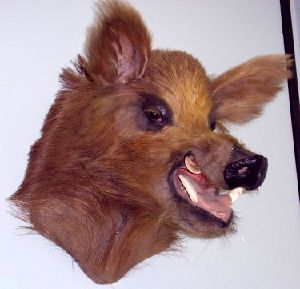
A very large swine dubbed Hogzilla was shot in Georgia, U.S., in June 2004 (Dewan 2005). Initially thought to be a hoax, the story became something of an internet sensation. National Geographic Explorer investigated the story, sending scientists into the field. After exhuming the animal and performing DNA testing, it was determined that Hogzilla was a hybrid of wild boar and domestic swine (ABC 2005).
At the beginning of the twentieth century, wild boar were introduced for hunting in the United States, where they interbred in parts with free roaming domestic pigs. In South America, New Guinea, New Zealand, Australia, and other islands, wild boar have also been introduced by humans and have partially interbred with domestic pigs.
In South America, also during the early twentieth century, free-ranging boars were introduced in Uruguay for hunting purposes and eventually crossed the border into Brazil sometime during the 1990s, quickly becoming an invasive species. Licensed private hunting of both feral boars and hybrids (javaporcos) was allowed from August 2005 on in the Southern Brazilian state of Rio Grande do Sul (SPF 2005), although their presence as a pest had been already noticed by the press as early as 1994 (GR 1994). Releases and escapes from unlicensed farms (established because of increased demand for boar meat as an alternative to pork), however, continued to bolster feral populations and by mid-2008, licensed hunts had to expanded to the states of Santa Catarina and São Paulo.
It must be kept in mind that those recently established Brazilian boar populations are not to be confused with long established populations of feral pigs (porcos monteiros), which have existed mainly in the Pantanal for more than a hundred years, along with native peccaries. The demographic dynamics of the interaction between feral pigs populations and those of the two native species of peccaries (collared peccary and white-lipped peccary) is obscure and is being studied presently. It has been proposed that the existence of feral pigs could somewhat ease jaguar predation on peccary populations, as jaguars would show a preference for hunting pigs, when these are available.
In the United States, as of 2008, the estimated population of four million feral hogs cause an estimated US$800 million of property damage a year (Brick 2008).
Natural predators
Wild boar are preyed upon by tigers (Yudakov and Nikolaev 2004), wolves (Graves 2007), striped hyenas, and other large predators in the areas that they co-exist.
Wolves mostly feed on piglets, though adults have been recorded to be taken in Italy, the Iberian Peninsula and Russia. Wolves rarely attack boars head on, preferring to tear at their perineum, causing loss of coordination and massive blood loss. In some areas of the former Soviet Union, a single wolf pack can consume an average to 50 to 80 wild boars annually (Graves 2007). In areas of Italy where the two animals are sympatric, the extent to which boars are preyed upon by wolves has led to them developing more aggressive behaviour toward both wolves and domestic dogs (Scheggi 1999).
Commercial uses
Boars are used for their meat and hair.
The hair of the boar was often used for the production of the toothbrush until the invention of synthetic materials in the 1930s. The hair for the bristles usually came from the neck area of the boar. While such brushes were popular because the bristles were soft, this was not the best material for oral hygiene as the hairs were slow to dry and usually retained bacteria. Today's toothbrushes are made with plastic bristles.
Boar hair is used in the manufacture of boar-bristle hairbrushes, which are considered to be gentler on hairâand much more expensiveâthan common plastic-bristle hairbrushes.
Boar hair is used in the manufacture of paintbrushes, especially those used for oil painting. Boar bristle paintbrushes are stiff enough to spread thick paint well, and the naturally split or "flagged" tip of the untrimmed bristle helps hold more paint.
Despite claims that boar bristles have been used in the manufacture of premium dart boards for use with steel-tipped darts, these boards are, in fact, made of other materials and fibers.
In many countries, boar are farmed for their meat, and in countries such as France, for example, boar (sanglier) may often be found for sale in butcher shops or offered in restaurants. However, the consumption of wild boar meat has been linked to transmission of hepatitis E in Japan) (Li et al. 2005).
Mythology, fiction, and religion
In Greek mythology, two boars are particularly well known. The Erymanthian Boar was hunted by Heracles as one of his Twelve Labors, and the Calydonian Boar was hunted in the Calydonian Hunt by dozens of other mythological heroes, including some of the Argonauts and the huntress Atalanta.
In Celtic mythology, the boar was sacred to the goddess Arduinna (Mariboe 1994), and boar hunting features in several stories of Celtic and Irish mythology. One such story is that of how Fionn mac Cumhaill ("Finn McCool") lured his rival Diarmuid Ua Duibhne to his deathâgored by a wild boar.
Ares, the Greek god of war, was represented with the ability to transform himself into a wild boar, and even gored his son to death in this form to prevent the young man from growing too attractive and stealing his wife, similar to Oedipus marrying his own mother.
The Norse gods Freyr and Freyja both had boars. Freyr's boar was named Gullinbursti ("Golden Mane"), who was manufactured by the dwarf Sindri due to a bet between Sindri's brother Brokkr and Loki. The bristles in Gullinbursti's mane glowed in the dark to illuminate the way for his owner. Freya rode the boar Hildesvini (Battle Swine) when she was not using her cat-drawn chariot. According to the poem Hyndluljóð, Freyja concealed the identity of her protégé Ãttar by turning him into a boar. In Norse mythology, the boar was generally associated with fertility.
In Persia, during the Sassanid Empire, boars were respected as fierce and brave creatures, and the adjective "Boraz (Goraz)" (meaning boar) was sometimes added to a person's name to show his bravery and courage. The famous Sassanid spahbod, Shahrbaraz, who conquered Egypt and the Levant, had his name derived Shahr(city) + Baraz(boar like/brave) meaning "Boar of the City."
In Hindu mythology, the third avatar of the Lord Vishnu was Varaha, a boar.
In Chinese horoscope the boar (sometimes also translated as pig), is one of the twelve animals of the zodiac.
The wild boar and a boar's head are common charges in heraldry. It represents what are often seen as the positive qualities of the boar, namely courage and fierceness in battle.
ReferencesISBN links support NWE through referral fees
- ABC. 2005. The mystery of hogzilla solved. ABC News March 21, 2005. Retrieved September 12, 2008.
- Bischoff, J., M. Domrachev, S. Federhen, C. Hotton, D. Leipe, V. Soussov, R. Sternberg, and S. Turner. n.d. Taxonomy browser: Sus Scrofa. National Center for Biotechnology Information (NCBI). Retrieved September 12, 2008.
- Brick, M. 2008. Bacon a hard way: Hog-tying 400 pounds of fury. New York Times June 21, 2008. Retrieved September 12, 2008.
- British Wild Boar (BWB). 2008. Wild boar Sus scrofa. British Wild Boar. Retrieved September 12, 2008.
- Clutton-Brock, J. 1987. A Natural History of Domesticated Mammals. Cambridge: Cambridge University Press. ISBN 0521346975.
- Dewan, S. 2005. DNA tests to reveal if possible record-size boar is a pig in a poke. San Francisco Chronicle March 19, 2005. Retrieved September 12, 2008.
- Global Rural (GR). 1994. Javali: Fronteiras rompidas ("Boars break across the border"). Globo Rural 9:99 (January 1994).
- Goulding, M. J., and G. Smith. 1998. Current status and potential impact of wild boar (Sus scrofa) in the English countryside: A risk assessment. Report to Conservation Management Division C, MAFF.]. UK Government, Department for Environment, Food, and Rural Affairs (DEFRA).
- Graves, W. 2007. Wolves in Russia: Anxiety Throughout the Ages. Calgary: Detselig Enterprises. ISBN 1550593323. Retrieved September 12, 2008.
- Heptner, V. G., and A. A. Sludskii. 1989. Mammals of the Soviet Union Vol. II, Part 2 Carnivora (Hyaenas and Cats). New York: Leiden. ISBN 9004088768.
- Horwitz, T. 2003. Blue Latitudes: Boldly Going Where Captain Cook Has Gone Before. Picador. ISBN 0312422601.
- Li, T.-C., K. Chijiwa, N. Sera, T. Ishibashi, Y. Etoh, Y. Shinohara, et al. 2005. Hepatitis E virus transmission from wild boar meat. Emerg Infect Disease 11(12). Retrieved September 12, 2008.
- Mariboe, K. 1994. Boar: Brahan seer. The Encyclopaedia of the Celts. Retrieved September 12, 2008.
- Scheggi, M. 1999. La Bestia Nera: Caccia al Cinghiale fra Mito, Storia e Attualità . Firenze: Olimpia. ISBN 8825379048.
- Scullion, C. 2007. Shiver me piglets! Null-hypothesis.co.uk. Retrieved September 12, 2008.
- Servico Publico Federal (SPF). 2005. Instrucao Normativa No. 71. Ministerio do Meio Ambiente, Brazil. Retrieved September 12, 2008.
- Seward, L. 2007. Pig DNA reveals farming history. BBC News September 4, 2007. Retrieved September 12, 2008.
- Yudakov, A. G., and I. G. Nikolaev. 2004. Chapter 13. General features of diet. Influence on prey populations. Competitors and scavengers. The Ecology of the Amur Tiger. Retrieved September 12, 2008.
Credits
New World Encyclopedia writers and editors rewrote and completed the Wikipedia article in accordance with New World Encyclopedia standards. This article abides by terms of the Creative Commons CC-by-sa 3.0 License (CC-by-sa), which may be used and disseminated with proper attribution. Credit is due under the terms of this license that can reference both the New World Encyclopedia contributors and the selfless volunteer contributors of the Wikimedia Foundation. To cite this article click here for a list of acceptable citing formats.The history of earlier contributions by wikipedians is accessible to researchers here:
The history of this article since it was imported to New World Encyclopedia:
Note: Some restrictions may apply to use of individual images which are separately licensed.
